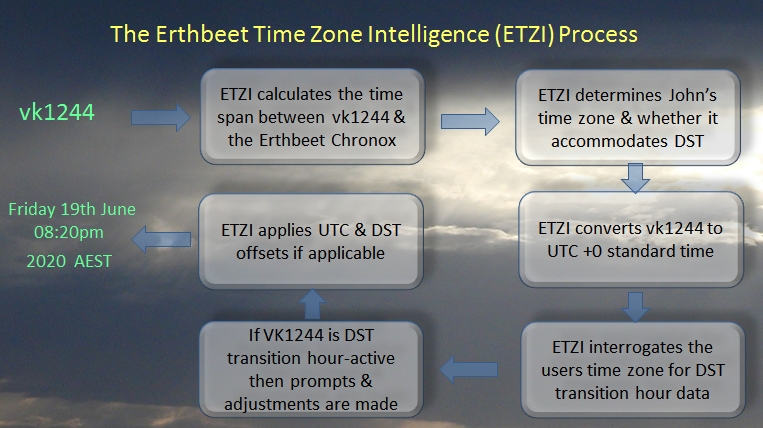Erthbeet Time Zone Intelligence (ETZI)
ETZI stands for Erthbeet Time Zone Intelligence & is the ‘brains’ needed to make a tokenzied time code ‘smart’. The Erthbeet time token is simply a mathematical code that represents one unique moment in time. For example, vp8544 is a universal moment in time, but it will decode into many different times (all meaning the same moment in time), depending on what time zone vp8544 is decoded in. In America, Houston, vp8544 would mean Sunday 12th July, 2020, 23:44 PM. But in London, vp8544 would mean Sun Jul 12, 2020 14:44. Both times mean the same moment, but are simply different time zones. Let’s not get confused with time-code fields on web pages. A time-code field on a web page is static, & represents a single time when clicked. As such, it doesn’t have to be very smart. But an erthbeet time code is dynamic, mobile & variable, & does have to be smart.
When someone sends an erthbeet time token out to the world, it is actually packaged into a clickable web link, which is called a Universal Time Link (UTL). For example the above erthbeet time: vp8544 would be posted as: https://erthbeet.com/ebt/vp8544. A Universal Time Link always has only one sender, but one or many recipients.
An Erthbeet Time Transaction is the process from when a sender composes & posts a UTL, until the time when a recipient clicks the UTL, after which it is then decoded into the recipient’s local time. So, when a UTL has been created by a sender & sent out to an audience, it is received by recipients & clicked. Clicking a UTL will then send it back to erthbeet.com for decosion. This is called a Time Transaction, because the same time token that Erthbeet created by a sender, is sent back to Erthbeet again by a recipient. Let’s look below at what ETZI must do for both a sender & the recipients of a UTL.
ETZI & Sending a Universal Time Link (UTL)
When a sender defines a time at the Timulator for posting, ETZI must examine the sender’s current time zone status, prior to building the time token. At this stage, ETZI is not interested in the actual time that the sender has entered, but only in the sender’s current time zone status. ETZI must check for the following conditions of the sender’s time zone prior to building the Erthbeet time token used to make a Universal Time Link:
- Is the sender’s time zone in daylight savings time?
- Is the sender’s time zone in the first hour of savings time?
- Is the sender’s time zone in the last hour of daylight savings time?
- Is the sender’s time zone in the first hour of Standard Time?
- Are any special adjustments for the sender’s time zone currently active?
ETZI & Recieving a Univeral Time Link (UTL)
As a UTL is typically posted on Twitter or other social media, there will usually be many recipients from different time zones who will click the UTL. When a recipient clicks a UTL, the enclosed time token is returned to Erthbeet for decosion. Unlike with the sender, ETZI doesn’t have so much work to do:
- What is the time zone of the recipient?
- Is the recipient’s time zone in daylight savings time at the intended moment of the UTL?
- Are there any special adjustments for the recipient’s time zone for the moment of the UTL?

So from the above outline of an Erthbeet Time Transaction, simply encoding time isn’t much use to anyone. A smart background agent is needed to determine not only time zone offsets, but has to deal very specifically with the sticky issue of the DST transitional hours, mainly from the sender’s point of view. Also note that ETZI must do all the hard work at encosion (sender) time. But at decosion (recipient) time, all the work has been done & is packaged inside the UTL time token.
In this way, the actual token is already ‘smart’ when it reaches recipients. But it cannot be ‘smart’ enough to know which time zone will request a local time decosion. So erthbeet decodes the UTL time token & examines the Daylight savings rules for the time zone of the recipient for the intended moment of the time token.
Erthbeet time is a platform-independent & dynamic time code protocol. This means that the erthbeet time protocol is not globally interpreted, but must rely on an Erthbeet Server for interpretation. ie: encosion & decosion must both happen on an erthbeet server. Hopefully in the future, the erthbeet time protocol, just like TCPIP, will be a global standard that will have global interpretation. We hope that this is where things are headed.
A Graphical Example of ETZI
Let’s say ‘John’ has read an erthbeet time, vk1244, in a newspaper, which is the time for a large asteroid entering the Earths atmosphere. Being an important event to him, he excitedly enters vk1244 into the Erthbeet conversion calculator. Following is what Erthbeet must do with vk1244:
a) vk1244 is referenced against the Erthbeet time-anchor called the chronox to find out when it is.
b) ETZI determines Johns time zone, from which the correct UTC offset can be applied.
c) ETZI then determines if DST (Daylight Savings) is active for vk1244 in Johns time zone.
d) ETZI then converts vk1244 to UTC standard time
e) Finally, ETZI applies the UTC & DST offsets to the time, applicable to John’s time zone.
With disappointment, John must wait some time for the event, as his local time for vk1244 is:
Thursday 28th May, 8:20pm 2020 AEST
The (EBT) Protocol & Erthbeet Time Zone Intelligence (ETZI) work together to eliminate time zone confusion. When someone enters an Erthbeet time at Erthbeet.com, Erthbeet Time Zone Intelligence (ETZI) will calculate & convert the Erthbeet time into the local time of the time zone configured on the users device. Erthbeet uses the local user-devices Time zone, but NOT its actual time. The time zone of the users device is considered the responsibility of the user to check & maintain, while the actual real-world time for the users time zone is authoritatively calculated & supplied by the Erthbeet time server. This is the time seen in the top left box of the Erthbeet calculator page: My Local Time.
Trying to understand how ETZI works can be confusing. It’s easier to just accept that it works & to use it. Give it a try – send out an Universal Time Link for a notable event to a group of your friends around the world! Why not post out your birthday as a Universal Time Link to remind your friends that it’s time to go shopping!










